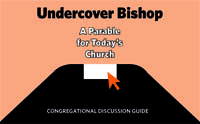The Squandering of a Small Congregation’s Reputation
 Church Vision: A Study in Black and White
Church Vision: A Study in Black and White
Congregations and clergy, including regional leaders, are often strangers to one another.
Regional leaders can know very little about the congregations they serve or the people who support them with their offerings.
It is not likely that they visit often with lay leaders. Even if they did, lay leadership shifts every couple of years or so.
Regional leaders have only two sources of information.
- Annual parish reports (completed and submitted by clergy)
- Pastors’ firsthand accounts which can not help but be delivered with self-interest.
Regional leaders are likely to come into contact with congregations at pivotal times in a congregation’s history.
- When they need to call a new pastor for any number of reasons.
- When there is some form of conflict, which often involves a pastor.
Consequently, regional leaders are likely to have a very biased view of a congregation.
When they don’t know what’s going on they fall back on numbers — not seriously considering what the numbers represent.
They might send someone to visit a church and report their findings. That visitor reports there are only 14 in worship. They have no way of knowing that 50 usual attendees are really upset about something that might involve the pastor. They are not going to hear about this from the pastor! They come to the conclusion that the church cannot survive. They never deal with the problems. When the regional body is hungry for assets, it is easy to reach this lazy conclusion.
The congregation then has a reputation among clergy. The memory for this reputation is quite long. Clergy might comment: “Wasn’t there trouble in 1960?” The congregation has no idea what they are talking about!
Lay people are often unaware of the power of the clergy gossip mill. They are unlikely to be part of the conversation that can spin out of control with no way to correct misunderstandings.
Clergy are sometimes so self-absorbed that they even come up with trendy slang. Years ago, pastors talked among themselves about alligators. “Who is the alligator in your church?” they might ask one another. An alligator in clergyspeak is a lay person who lurks in the congregational water ready (in this clergy person’s mind) to snap its jaws on a pastor’s throat. Paranoia? Perhaps! It reflects neither love nor respect for their flock. It does untold damage to a congregation within the Church—all the less fortunate when it voids the congregation’s reputation outside of ecclesiastic circles.
Every congregation has a reputation in its community. Clergy can influence it or they can exist totally unaware of it.
This reputation spans longer periods of time—generations—and takes in the community’s knowledge of the congregation’s participation and response to community needs and the lives they have touched that may not be part of the congregation’s membership or collected statistics.
The community measures churches with a different yardstick.
- They work together on community projects.
- Their children attend schools and programs sponsored by the church.
- The community can count on the congregation to share their facilities generously.
- The community remembers a congregation’s response to a local disaster.
- They may have acquaintances and family members whose lives were touched in some small but significant way.
- The community knows nothing and cares less about denominational involvement or reputation. They only know what they see and that’s the local congregation and its members.
A regional body has no way of measuring this, except as filtered through the clergy. Too bad. This reputation is an asset to the entire denomination. It is far more powerful than slogans or logos or even press releases.
The challenge to the Church is to know a congregation’s reputation and protect and nurture it. It must learn to separate the truth from the gossip. This becomes difficult when the regional body’s interests are limited to placing pastors and accumulating assets.
2×2 published a parable about this division between clergy and lay leaders and how it impacts the small church and the mission of the church. It is based on our 60 visits to local congregations—most of them quite small. It is meant to spark discussion on how clergy and laity can work together and advance mission with the limited resources (both human and financial) which define today’s church.
 Read Undercover Bishop. Share its short chapters weekly with your congregation. Ask if they see themselves anywhere in the story. Study questions are included at the end of the book.
Read Undercover Bishop. Share its short chapters weekly with your congregation. Ask if they see themselves anywhere in the story. Study questions are included at the end of the book.
